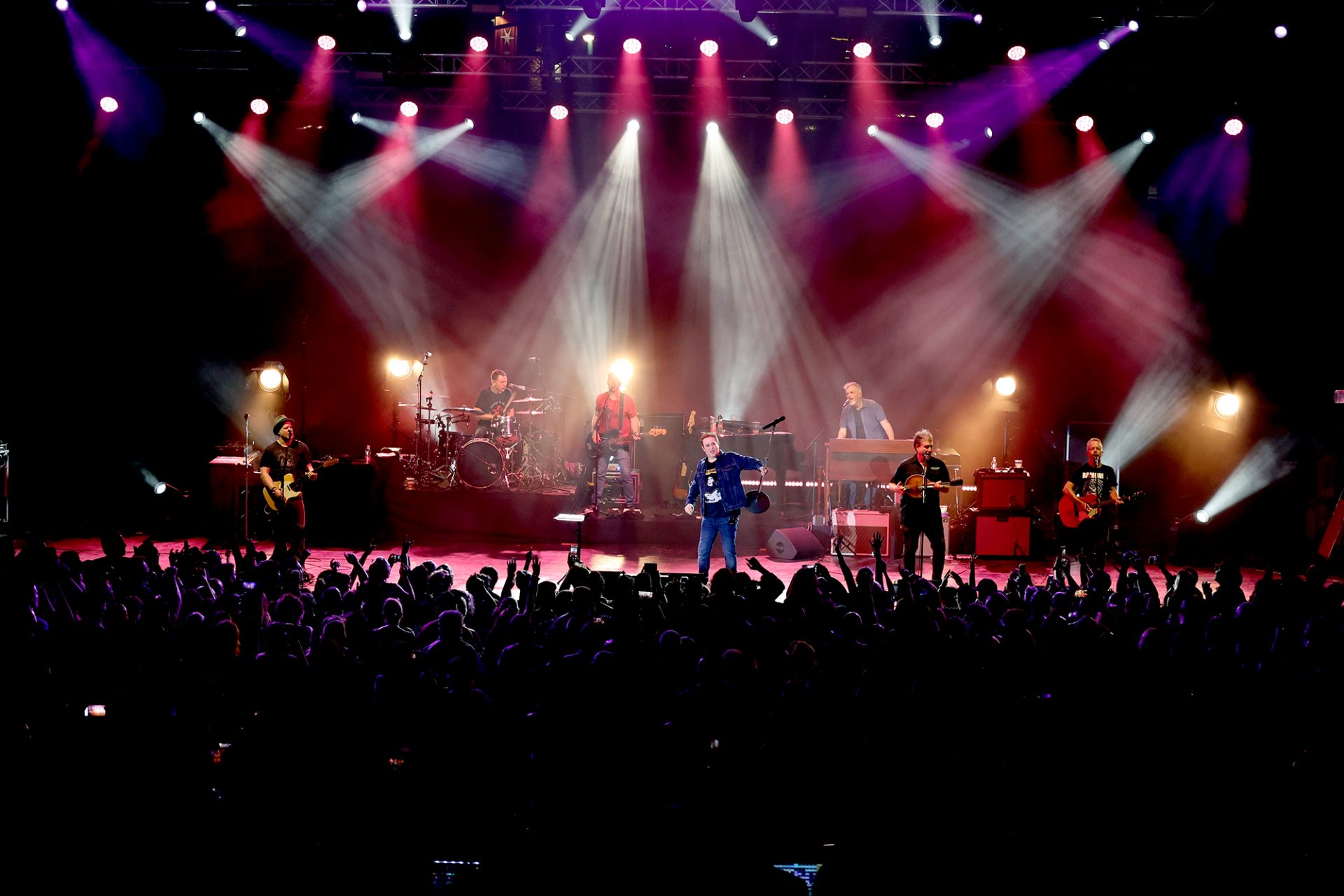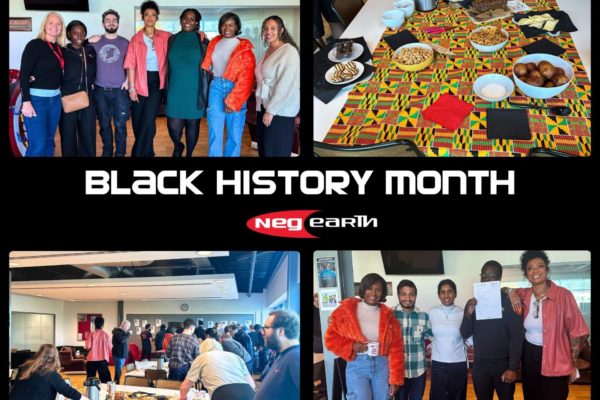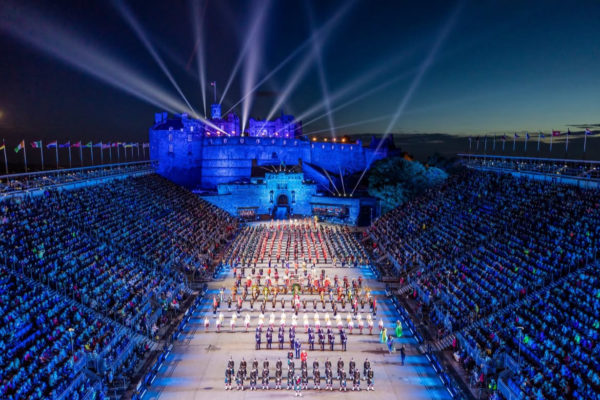Counting Crows Butter Miracle Europe Tour 2022
The GRAMMY and Academy Award-nominated American rock band Counting Crows toured Europe this year on their Butter Miracle Tour. Neg supplied a touring floor package alongside flown ‘tungsten’ elements. Key fixtures used included Martin MAC Viper Profiles and GLP JDC1 LED Strobes.
We interviewed Harry Smith, Neg Crew member, to gain a better insight into the behind-the-scenes action of the show.
Harry went to The Guildford School of Acting and has a BA Hons in Professional Production Skills, with a focus on lighting. He spent some time in almost every sector of the industry before crewing with Neg Earth. He mainly focused on lighting programming, but now prefers being on the floor with the nuts and bolts to being behind the scenes. He started in the music touring & live events industry with Neg and has been crewing with us for six years.
What did a typical day look like as a crew member for the Counting Crows show?
9AM – Day starts with a walk around with the Production Manager, Stage Manager, Lighting Director and Promoter’s rep. This tour played venues of varying sizes, so this is largely a negotiation of what is possible, what’s available to use, and what’s been agreed in advance.
10AM – Load in starts.
12PM – By this point we hope to have all our package in, and the focus shifts to make sure Joel, the LD, is happy. This means tying in our network package into whatever system they are using in house, liaising with the venue re: smoke & haze, getting hooked up to the follow-spots etc.
1PM – Lunch!
2PM – It’s at this point that I look to make sure that the lighting system is ‘signed off’. Working methodically through the whole system, I check with Joel that everything is working as it should, that all the house equipment is functioning, and he is ready to get programming the show for the day.
6PM – Dinner!
6:30PM – Doors open! Before public entry, I make sure Joel is happy, and everything still works before the public comes into the space.
8PM – Support Act. I pop my head in before the act starts and make sure everything is running smoothly.
8:30PM – Changeover. This is where my real workday begins again. I check in at FOH that Joel is show ready, his comms to the follow-spots work, the follow-spot ops have arrived and know how they work. I let the stage manager know we are ready to go and settle in at dimmers to be ready to respond to any issues during the show.
9PM – Show time!
11PM – Show down and the load out begins. On a tour like this, there’s not a lot we can do until all the instruments are off the stage, so I help where I can and get any lighting that will impede someone out of the way early. You try to be generally helpful while generally staying out of the way until it’s your turn. We’re always working with the SM to make sure that we are doing things in the order that they expect.
12:30AM – Truck is loaded, time for a shower, a quick bite to eat, maybe a beer if that’s your thing and to bed – ready to start all over again tomorrow in a new city, in a new country!
What made being a crew member on this show unique in comparison to other shows?
The thing that really made this one unique is being on your own. You have a lot of hats to wear – you are the network tech, the crew chief, the dimmer man, the lighting tech, the follow-spot tech. This sometimes means that your attention is being pulled in a lot of directions at once, and people need you to be in more than one location at once. It can make getting what you actually need to get done – which is put the lights out and plug them in – hard.
The way you solve this is by developing good working relationships with the people around you and leaning on them for support. This means getting the stage manager on side, getting the lighting designer involved and getting backline techs working with you in tandem. I liked getting in early and getting all the questions and queries ironed out before too many people start to show up – that way at least you only need to try to be in 2 or 3 places at once, not 4 or 5!
Did you face any challenges as a crew member for this show?
The primary challenge of a tour like this is creating a flexible solution to the designed package, that allows you to chop and change as much as possible while remaining fast and efficient to load in. You can quickly get into a mess when things change every day, chasing your tail around creating more problems than you solve.
This is where working for Neg Earth is such a pleasure. Firstly, as someone early in their career I can lean on the huge diversity of experience from the Neg Earth crew that have been there, done it all and got the pictures to prove it. Secondly, that experience is present in the products and solutions that Neg Earth can provide. Racks, power distribution and product choices are well considered and cohesive – that enables the building of a robust, flexible system. For example, having small patchable racks like the LSC enables the cabling to stay the same every day but adapt to a variety of both package sizes and power sources available.
Being flexible on site requires having a pragmatic view of the whole day and knowing when to push for something and when to back off. The easiest way to have an easy day is keeping everyone on side. This means not being tied to any particular idea, changing things often, and maybe – as it was on this tour – never doing it the same way twice!
What do you like about being a Crew member in general?
For me, the highlight of it is the travel and the people you meet along the way. The industry is full of some incredible characters unlike any other workplace in the world. You get to spend your time with these people, in some of the most beautiful places in the world. That’s a real gift and an honour that I try not to forget.
I don’t think that touring is a ‘solved’ problem, and with every project I, my colleagues and the suppliers we work with learn more and more. It feels as soon as you catch up, the creative teams come up with something bigger and better, and now you’re learning all over again. I think it’s a rare privilege to have a job that evolves at such a rapid pace like this. Every tour is a new challenge, a new puzzle and a new set of skills.
Were there any lighting features that were unique to this show?
We had these large light bulbs hanging all over the place that posed a few challenges. The first challenge was sourcing them – which the Neg Earth procurement team eventually nailed after a dogged three-week search. The second challenge was making them safe. Such a large glass fixture has a risk of exploding and showering the stage in glass. So, these were then dipped in a protective coating to stop any chance of the glass shattering above the stage.
What do you think is the most important aspect of a live performance?
I think the obvious answer here is to say the ‘music’ or the ‘audience love it’. But I have a different answer.
For me the most important aspect of a live performance is that everyone gets to go home at the end of the day to their loved ones – artists, crew, and the audience. The UK entertainment industry has a remarkable safety record. There have been dozens of accidents this year around the world that are a stark reminder that this safety record cannot be taken for granted. The most important question at a live event isn’t “can this be done?” but “can this be done safely?”.
At Neg Earth we are lucky to have people like Will Murray-Jones who help us with this on the road, but also the real focus in the yard on using equipment that is well looked after, correctly specified and with current inspection certifications.
Do you have any advice for someone aspiring to be a crew member in the future?
A strong desire to come and be on the floor, as a nuts and bolts, wingnuts and spanners, Bonafide lighting technician.
It can be a hard industry to crack into, and at the moment the best way to do it is come and be a friendly, intelligent, good humored person willing to muck in and get things moving on the floor. There is a huge shortage of people who want to do this at the moment. I don’t think it’s ever been easier to get yourself on a tour than it is right now.
The other thing I would say is eliminate the phrase “that’s not my job” from your vocabulary. That’s not to say you should start loading in the PA, but that when you’re starting out you don’t have the experience to start dictating what is or isn’t your job. It’s all new, you have a lot to learn (you always will), and if there’s something to be done – you should be getting involved! Every skill is a string to your bow. The judgement of a technician isn’t how much work you’re getting in the height of summer – but how much work you get in the slow periods. You want to be the first person your project managers think of when they need a strong all-rounder and a team player. That’s how you get recognised and remembered.
What do you like about this industry?
I’ve come to love this side of the industry over the others. The scale is immense, there is the budget to do things properly and I enjoy what I consider the true challenges of the industry – managing all the different personalities and stakeholders under huge time pressures.
In the medium term I’m excited to keep growing my skill set and move on to crew chief roles on shows of increasing size in line with my ability. In the long term I’m interested in solving industry problems with technical & product solutions – in whatever fashion that takes.
What is your proudest achievement?
It’s always hard to nail down one achievement that I am most proud of, because each tour brings its own challenges and learning experiences. However recently I was involved with the Benefit Concert for Ukraine with ITV and Neg Earth, and it holds a special place in my heart.
Lighting Designer : Alex Skowron
Touring Lighting Director : Joel Reiff
Production Manager : Kory Carter






